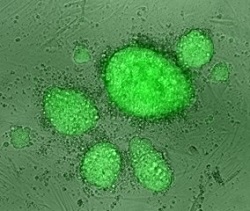 |
| A new method produced a colony of induced pluripotent stem cells derived from one adult cell.--Courtesy of the Laboratory of Matthias Stadtfeld, NYU Langone Medical Center |
As the first clinical trial using induced pluripotent stem cells begins in Japan, researchers in the U.S. have made a separate discovery that may help get stem cell-based therapies into humans more quickly.
Scientists at the New York University Langone Medical Center have developed a new technique that uses three familiar compounds, including vitamin C, to generate adult stem cells into pluripotent stem cells at a dramatically efficient rate--more than 20-fold compared to the current method. The findings appear Sept. 18 in the journal Stem Cell Reports.
"Induced pluripotent stem cell derivation is a very reproducible process but it's also a very inefficient process," study author Matthias Stadtfeld, an assistant professor of cell biology NYU Langone Medical Center, told FierceBiotechResearch.
First engineered by Shinya Yamanaka at Kyoto University in Japan in 2006, the original cell reprogramming method involves the artificial expression of four key genes dubbed OKSM--for Oct4, Klf4, Sox2 and myc--which collectively act to slowly prompt cells into an immature, embyronic-like state.
The work was heralded as a breakthrough in science, and Yamanaka won a Nobel Prize for his findings. But a practical issue of converting adult cells into induced pluripotent stem cells, or iPSCs, remains. The transformation process can take weeks, and the yield rate of pluripotent cells is only about 1%.
"What we set out to do was test the number of chemical compounds that were found individually to enhance the formation of iPS cells that could be combined for a more dramatic enhancement of cell formation," Stadtfeld said. The goal was to find chemical compounds that modulate enzymes found in most cells. Stadtfeld was particularly interested in identifying compounds that could produce a high number of iPSCs compared to the Yamanaka technique.
Stadtfeld and his team found two compounds that influence well-known signaling pathways, called Wnt and TGF-β, which modulate several growth-related processes in cells. The third, vitamin C, was recently found to aid in iPSC generation by activating enzymes that alter chromatin--the spiral scaffold for DNA--to regulate gene expression.
Researchers tested out this compound combination on mouse skin fibroblasts, the most common cell type used for iPSC research, and found that using all three yielded an 80% conversion rate over one week. In another series of experiments, investigators used the compound trio on blood progenitor cells, which showed a conversion rate of up to 30% on its own and nearly 100% when combined with OKSM.
Vitamin C and the two compounds used to manipulate the Wnt and TGF-β pathways have few unknown or hazardous effects, the researchers said, making it a potentially safer iPSC method than the traditional route. OKSM has the potential to cause harmful side effects because of its use of viral vectors to carry new DNA information into adult cells.
- get the open-access study in Stem Cell Reports (PDF)